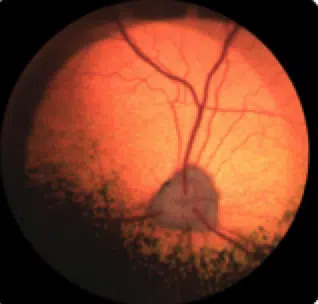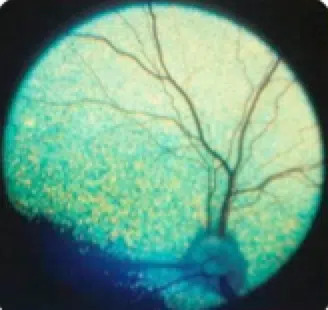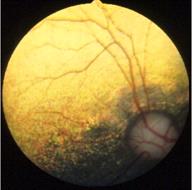Abstract
Sudden Acquired Retinal Degeneration (SARD) is a rapidly progressive and irreversible condition afflicting the retinas of dogs primarily, leading to sudden and profound bilateral blindness.

Despite its clinical significance, the etiology of SARD remains poorly understood, with autoimmune mechanisms and retinal apoptosis implicated in its pathogenesis.
This article comprehensively explores SARD, including its disease entity, etiology, clinical presentation, diagnosis, treatment options, prognosis, and relevant references.
Early detection and management strategies are pivotal in mitigating the impact of this debilitating ocular disorder and optimizing the quality of life for affected animals.
Disease Entity
Sudden Acquired Retinal Degeneration (SARD) is a rapid-onset degenerative disease that leads to profound and irreversible vision loss in animals, primarily dogs.
Characterized by sudden and severe bilateral retinal degeneration, SARD results in rapid and complete blindness within days to weeks of onset.

While the precise mechanisms underlying SARD remain poorly understood, autoimmune factors and retinal apoptosis are believed to play significant roles in its pathogenesis.
Etiology
The exact etiology of Sudden Acquired Retinal Degeneration (SARD) remains elusive, with several theories proposed to elucidate its pathogenesis.
Current research suggests an autoimmune-mediated process triggered by an immune response against retinal proteins, resulting in widespread retinal apoptosis and subsequent degeneration.
Genetic predisposition, environmental factors, and underlying health conditions may also contribute to the development of SARD in susceptible individuals.
Clinical Presentation
SARD typically presents as a sudden and profound bilateral vision loss in affected animals, primarily dogs.
Clinical signs may include sudden onset of complete blindness, dilated pupils unresponsive to light (mydriasis), absent or markedly reduced pupillary light reflexes, and normal or minimally altered funduscopic examination findings.

Additionally, affected animals may exhibit behavioral changes indicative of visual impairment, such as disorientation, bumping into objects, and reluctance to navigate familiar surroundings.
Diagnosis
Diagnosing Sudden Acquired Retinal Degeneration (SARD) requires a comprehensive ophthalmic evaluation conducted by a qualified veterinarian or veterinary ophthalmologist. Diagnostic steps may include:
- Ophthalmic Examination: Assessment of visual function, pupillary light reflexes, and funduscopic examination to evaluate retinal health and integrity.
- Electroretinography (ERG): Objective assessment of retinal function using electroretinography to detect abnormalities in retinal electrical responses characteristic of SARD.
- Blood Tests: Serological testing to assess for autoimmune markers and rule out underlying systemic conditions associated with SARD.
- Advanced Imaging: Imaging modalities such as optical coherence tomography (OCT) or retinal photography may be utilized to visualize and document retinal changes associated with SARD.
Treatment
Currently, there is no definitive treatment for Sudden Acquired Retinal Degeneration (SARD), and management primarily focuses on supportive care and adaptation to blindness. Symptomatic treatment options may include:
- Environmental Modification: Ensuring a safe and familiar environment for the blind animal by minimizing hazards and maintaining consistent routines.
- Behavioral Adaptation: Implementing behavioral training techniques to facilitate orientation and mobility in the absence of vision.
- Supplementation: Some veterinarians may recommend nutritional supplements or antioxidants to support overall retinal health, although their efficacy in managing SARD remains uncertain.
- Ongoing Monitoring: Regular follow-up examinations to monitor for disease progression and assess the animal’s quality of life.

Prognosis
The prognosis for animals diagnosed with Sudden Acquired Retinal Degeneration (SARD) is guarded, as the condition typically leads to irreversible blindness.
While affected animals can adapt remarkably well to vision loss with appropriate supportive care and environmental modifications, SARD represents a significant challenge for both the animal and its caregivers.
Early detection, proactive management, and ongoing support are essential for optimizing the quality of life for animals affected by this debilitating condition.
Would you have interest in taking retinal images with your smartphone?
Fundus photography is superior to fundus analysis as it enables intraocular pathologies to be photo-captured and encrypted information to be shared with colleagues and patients.
Recent technologies allow smartphone-based attachments and integrated lens adaptors to transform the smartphone into a portable fundus camera and Retinal imaging by smartphone.
RETINAL IMAGING BY YOUR SMARTPHONE
References
- Oliver, J. E., & Lorenz, M. D. (2014). Handbook of Veterinary Neurology (5th ed.). Elsevier Health Sciences.
- Hurn, S. D., & Maggs, D. J. (2018). Feline Sudden Acquired Retinal Degeneration Syndrome. Veterinary Clinics of North America: Small Animal Practice, 48(5), 979-992.
- Deeg, C. A., & Reese, S. (2013). Diagnosis and Management of Canine Retinal Diseases. In Advances in Veterinary Ophthalmology (pp. 172-194). John Wiley & Sons.
- Zarfoss, M. K., Dubielzig, R. R., Ehrhart, E. J., Grahn, B. H., & Lyons, L. A. (2007). Sudden acquired retinal degeneration in the dog: clinical and genetic characterization. Veterinary Ophthalmology, 10(3), 131-138.
RETINAL IMAGING BY YOUR SMARTPHONE

RETINAL IMAGING BY YOUR SMARTPHONE

